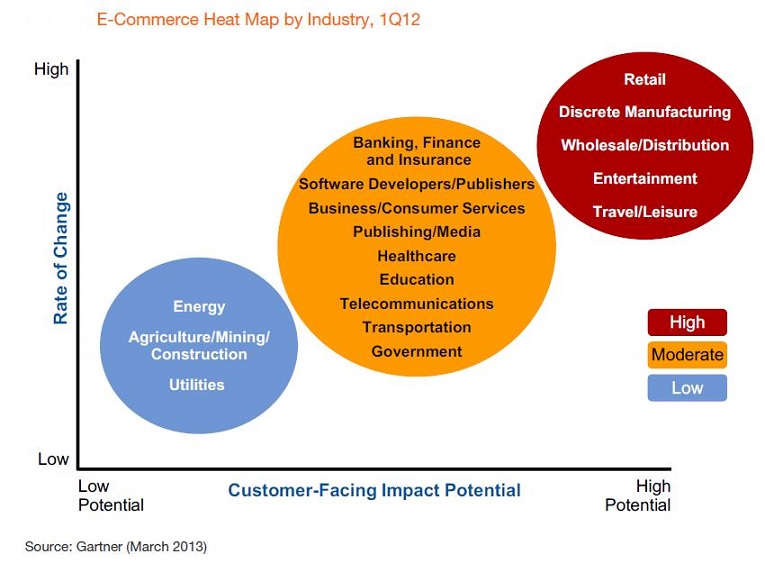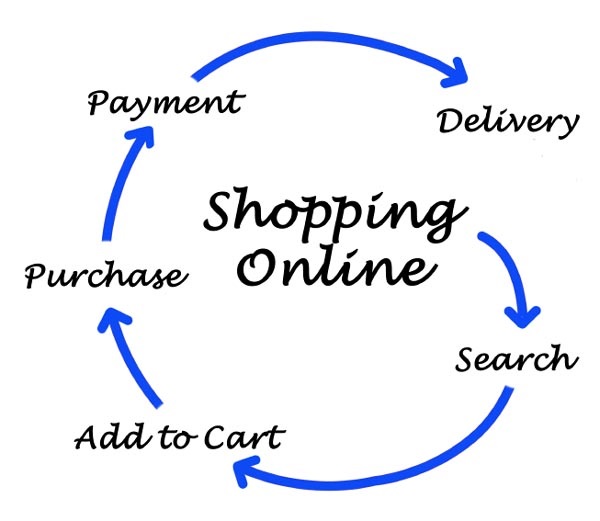This is Part 1 of a multipart blog series explaining trends in eCommerce as a result of underlying trends in technology and how ecommerce providers can maximize ROI with the help of proactive performance monitoring.
eCommerce is growing at 17% per year. Last year, the US holiday season rang up more than $600 billion dollars in revenue, and online and eCommerce generated $102 billion of that. But unfortunately eCommerce is stereotyped as an online version of the retail industry. It is much more than that. In 2013 Gartner produced a report laying out various industries by their eCommerce potential. Retail, wholesale, travel and entertainment made it to the top. No surprises there. But some were surprised by seeing traditional industries such as mining, agriculture, government, education etc. on there.

A lot has changed in the past two years; the not so eCommerce-y industries have come a long way in terms of online presence. Those who don't provide online shopping see the offline sales are being influenced by the online presence. We've seen feed manufacturers, steel distributors, and even utility providers using eCommerce to expand the geographical reach. Automotive and aerospace go the eCommerce way in the aftermarkets. All things said, eCommerce is relevant across all industries and it's growing at an exponential rate.
Everyone who provides eCommerce understands the significance of website or mobile application performance and how it directly hits the bottom line. And those who are new to eCommerce have started realizing the monetary consequences of page loads and bounce rates. When Amazon was down in 2013, they lost more than $60K per minute. BestBuy faced a huge social media backlash when shoppers couldn't use Bestbuy.com during holiday season. On the flip side:
"By reducing page load time to 1.2 seconds from whopping (!) 6 seconds, Shopzilla saw 12% increase in revenue"
"AutoAnything.com increased conversion rates by 9% by cutting down the load time by half."
You get it; poor eCommerce performance directly hits your bottom line. No matter what industry you are in, you should be monitoring your websites, web applications and mobile applications to ensure that your customers and end users can do what they wish to do.
Poor eCommerce is no different than going to a physical store, and seeing that it's closed or only few checkout lanes are open and there is a huge line. What do you do if it takes too long? You switch the lanes or you go to a different shop. That other lane in the eCommerce world is a different website, a different eCommerce store, maybe a competitor.
eCommerce Ecosystem
Modern eCommerce heavily relies on external and third-party components for critical functionalities such as search, cart and payment etc. And how can we forget the online advertising and social media plugins that bring traffic? Last holiday season, more than 30% of eCommerce traffic was routed by social media plugins. Companies that provide the following important eCommerce functionalities via plugins, APIs, applications or tools are important players in the eCommerce ecosystem.

If your company is part of the eCommerce ecosystem, the enormity of the eCommerce opportunity and growth applies to you! Google maps, PayPal, Elasticsearch, Evernote, Flickr get more than billion calls every day. Expedia quoted that 90% of its revenue comes from API business. In 2013, Salesforce generated 50% of its $3B revenue via APIs. Let's say you are the provider of payment processing API. It is your responsibility to ensure that your API is available 24x7, performing per your consumer's requirements and is returning right data at the right places. A poor performing API slows down the adoption, results in poor rating and reduced brand equity, finally reducing revenue.
As an eCommerce provider or part of the eCommerce ecosystem, you can leverage the entirety of eCommerce opportunity with proactive monitoring.
In the upcoming parts of this blog series, we will cover the trends in eCommerce as a result of trends in technology, the special case of peak season and how you can maximize the eCommerce ROI with proactive performance monitoring.
Read Part 2: Maximizing eCommerce ROI - Understanding the Latest Trends
Priyanka Tiwari is Product Marketing Manager, AlertSite, SmartBear Software.
The Latest
A vast majority (89%) of organizations have rapidly expanded their technology in the past few years and three quarters (76%) say it's brought with it increased "chaos" that they have to manage, according to Situation Report 2024: Managing Technology Chaos from Software AG ...
In 2024 the number one challenge facing IT teams is a lack of skilled workers, and many are turning to automation as an answer, according to IT Trends: 2024 Industry Report ...
Organizations are continuing to embrace multicloud environments and cloud-native architectures to enable rapid transformation and deliver secure innovation. However, despite the speed, scale, and agility enabled by these modern cloud ecosystems, organizations are struggling to manage the explosion of data they create, according to The state of observability 2024: Overcoming complexity through AI-driven analytics and automation strategies, a report from Dynatrace ...
Organizations recognize the value of observability, but only 10% of them are actually practicing full observability of their applications and infrastructure. This is among the key findings from the recently completed Logz.io 2024 Observability Pulse Survey and Report ...
Businesses must adopt a comprehensive Internet Performance Monitoring (IPM) strategy, says Enterprise Management Associates (EMA), a leading IT analyst research firm. This strategy is crucial to bridge the significant observability gap within today's complex IT infrastructures. The recommendation is particularly timely, given that 99% of enterprises are expanding their use of the Internet as a primary connectivity conduit while facing challenges due to the inefficiency of multiple, disjointed monitoring tools, according to Modern Enterprises Must Boost Observability with Internet Performance Monitoring, a new report from EMA and Catchpoint ...
Choosing the right approach is critical with cloud monitoring in hybrid environments. Otherwise, you may drive up costs with features you don’t need and risk diminishing the visibility of your on-premises IT ...
Consumers ranked the marketing strategies and missteps that most significantly impact brand trust, which 73% say is their biggest motivator to share first-party data, according to The Rules of the Marketing Game, a 2023 report from Pantheon ...
Digital experience monitoring is the practice of monitoring and analyzing the complete digital user journey of your applications, websites, APIs, and other digital services. It involves tracking the performance of your web application from the perspective of the end user, providing detailed insights on user experience, app performance, and customer satisfaction ...







